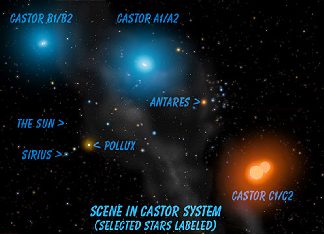Castor (Alpha Geminorum)

Castor (Alpha Geminorum) is the second brightest star in the constellation Gemini and, in mythology, the twin of Pollux. Though appearing as a single white star to the naked eye, Castor is really a remarkable multiple system, consisting of three stellar pairs.
A modest telescope shows two similar A stars, of mid-second and mid-third magnitude, a couple of arcseconds apart, which orbit each other every 380 years. About 1 arcminute to the south lies a ninth magnitude third companion that orbits the bright pair at a distance of about 1,000 astronomical unit (AU). A spectrograph shows that each of the two bright components, A and B, is itself a double. Castor A consists of almost identical stars, each of about 2 solar masses, orbiting each other every 9.22 days and about one-tenth the distance of Mercury from the Sun. Castor B's twin stars orbit even faster, making their circuit in a mere 2.9 days. The faint, distant star, Castor C, is also double, consisting of nearly identical, low-mass M stars – red dwarfs – with temperatures of about 4,000 kelvin, some two solar diameters apart with an orbital period of 20 hours. One or both are flare stars.
Castor is part of a group of widely dispersed stars known as the Castor Moving Group (see below).
| visual magnitude | 1.58 |
| absolute magnitude | 0.58 |
| spectral type | A1V + A2V |
| distance | 52 light-years |
| position | RA 07h 34m 36s, Dec +31° 53' 18" |
Castor moving group
The Castor moving group is an extensive but physically related group of more than 50 stars, including Castor itself, Vega, Fomalhaut, Alderamin, and Zubenelgenubi, that has a common motion through space. The properties of the group suggest an age for its members of 100 to 300 million years.


